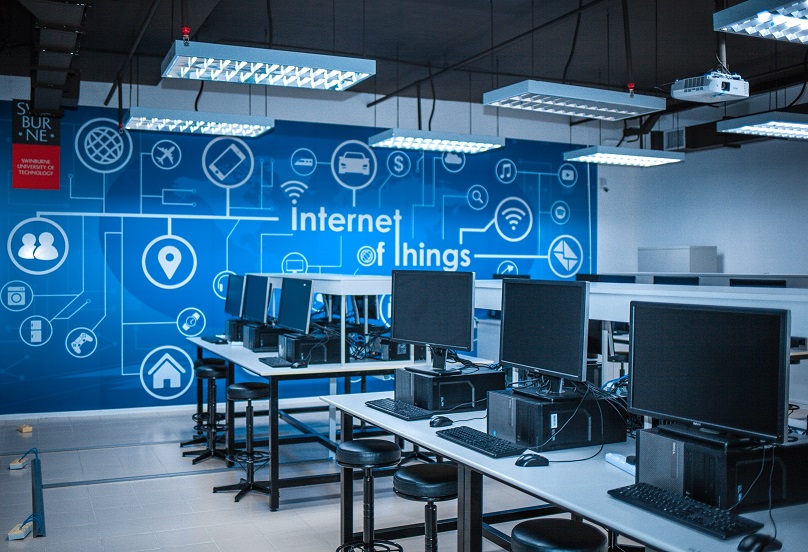Written by Dr Mark Tee K. T. This article was originally published in The Borneo Post, Campus & Beyond column on 14 April 2021.
A popular toy line by Takara and Hasbro hit television sets across the world in the 1980s. Titled Transformers: More than Meets the Eye, the beloved series featured warring factions of sentient mechanoid aliens adept at disguising themselves as everyday vehicles. Their stories inspired our childhoods alongside G.I. Joe, MacGyver, The X-Files, Beyond 2000, and other timeless classics.

Little did we know that around the same time sparked the growth of a unique concept called Ubiquitous Computing that also seeks to embed digital intelligence within everyday objects. Its inception was simple enough – now that Personal Computers are fast becoming a common household item, can we upgrade our refrigerators, TVs, cars or even our clothes with similar capabilities? Forget laptops and cell phones, can we digitise our bodies?
This idea spawned a vast catalogue of ‘smart’ appliances such as programmable ovens; self-regulating heaters and air conditioners; automatic transmission drive in cars; commuter trains; and more. Some adventurous souls even push the boundaries of body modification by voluntarily introducing implants that communicate their digital identities wirelessly.
These sound like the stuff of Sci-Fi movies, but I assure you, it is fast becoming our reality. Forget shows like Total Recall, Minority Report, and the Surrogate; you need but take a closer look to realise that the only thing stopping a super Artificial Intelligence (AI) like Skynet from controlling every toaster, camera and Roomba on the planet is a globally connected communications network. Oh wait, there is one! We know it as the Internet.
And behold, the Internet of Things (or IoT) is born. It is often used to describe a system of interconnected smart devices that communicate with one another through the Internet. They do this to amass vast mountains of user data from you and everyone else on the planet. This is done with a fundamental purpose in mind – to digitally study human behaviour. Skynet clichés aside, please consider the altruistic notion that technology exists to enhance our existence as a species.

Imagine the possibilities of understanding the collective preferences, exercise, hobbies, habits, and relationships of every person on Earth. We now know that the average activity level for maintaining a healthy heart can be roughly achieved by walking 10,000 steps a day. We also know that your changing heartrate can be indicative of stress levels or sleep quality. Your sleep is also affected by how much time you spend on social media.
Social media is not the only source of that new recipe you are about to attempt; it was suggested by the phone app that came attached to the new Sous Vide your husband bought last Christmas. “Cooking will never be the same again”, you thought, almost forgetting that your shiny refrigerator who has been ordering new eggs to replenish your dwindling stock.
We can do this now, thanks to our host of intelligent ‘Things’. They may already be all around you right now. Your smart TV, smartphone, microwave oven, Alexa, Xiaomi Mijia set, Daikin WiFi air conditioner, Garmin watch, or even car could be Internet-connected, and are communicating what they learnt about you as you are reading this article on your tablet (who is probably watching you too). Take a step back for a moment and consider: isn’t the most successful piece of technology, one that you do not even realise exists until it is gone?

However, IoT is a double-edged sword. On the flip side, it is easier than ever to be exposed to identity theft, credit card spoofing, infringement of privacy, scams, and more. Today, we no longer leak personal information like our addresses, pictures, and favourite hotspots through Facebook. When used irresponsibly, IoT can potentially expose your exact whereabouts, health issues, activities and more. The modern criminal sits comfortably behind a screen halfway across the world as he turns your coffee machine and a million other victim machines into part of a Mirai Botnet army to shut down government websites.
Thankfully, these implications, as horrifying as they appear, have already been constantly anticipated, countered, and designed against by our leading ICT workforce in cybersecurity, networking, and R&D. The never-ending battles against cyber-threats rage on, with IoT being amongst the latest battlegrounds in this invisible war.
IoT is a huge umbrella of sensor, communications and intelligence technologies that source human data into bleeding edge computing concepts such as Big Data, Machine Learning and Data Science. Its manufacture, maintenance and development are spearheaded by a new generation of multidisciplinary specialists who combine computer science, engineering, and flair for breaking new grounds in state-of-the-art electronics, robotics, and AI. This is a fast-paced field that is rapidly growing out of Industry 4.0 relevance and into a necessity for increasingly ‘smart’ communities worldwide.
Just like the famous Borg saying, ‘resistance is futile’. Our connected future with IoT has come, and it is here to stay. If you want to know more, the answers are quite literally in your hands – just a Google Search away.
________________________
Swinburne Sarawak’s School of Information & Communication Technologies offers the three-year Bachelor of Computer Science, and Bachelor of Information and Communication Technology programmes. For the computer science programme, students can choose from a range of major including cybersecurity, software development, artificial intelligence (AI), data science, and IoT.

The IoT major is offered as a response to industry calls for headstrong candidates willing to harness the science of integrating systems and a passion for independent lifelong learning. The university also has ongoing industrial IoT research projects in various areas of application, ranging from interactive social exercise assistance for stroke survivors and urban waste collection management to developing novel combinations of connected monitoring systems for modern streamlined farming and composting, in Sarawak.
Meanwhile, the ICT bachelor’s programme offers two choices of major namely network technology and software technology. All programmes are accredited by Australian Computer Society (ACS) and Swinburne Sarawak is also a recognised CISCO Academy partner.
Recent SPM school-leavers who are interested to pursue an IT programme can get the ball rolling by enrolling into the Fast-Track Swinburne Foundation programme today! Upon successful enrolment, students can start their online learning immediately on 5 July 2021 without any payment for the first two weeks with the Start With Zero Fees Programme.
Upon successful completion of the Swinburne Foundation Studies (Information Technology/Multimedia), students can progress directly to a Bachelor’s degree programme as early as March 2022 – choosing either the Bachelor of Computer Science or Bachelor of Information and Communication Technology programme.
For details, contact Swinburne’s Education Counsellor via WhatsApp at 019-819 6353 or email to study@swinburne.edu.my. Online counselling on demand is also available from Monday to Sunday, 10am to 10pm daily.

